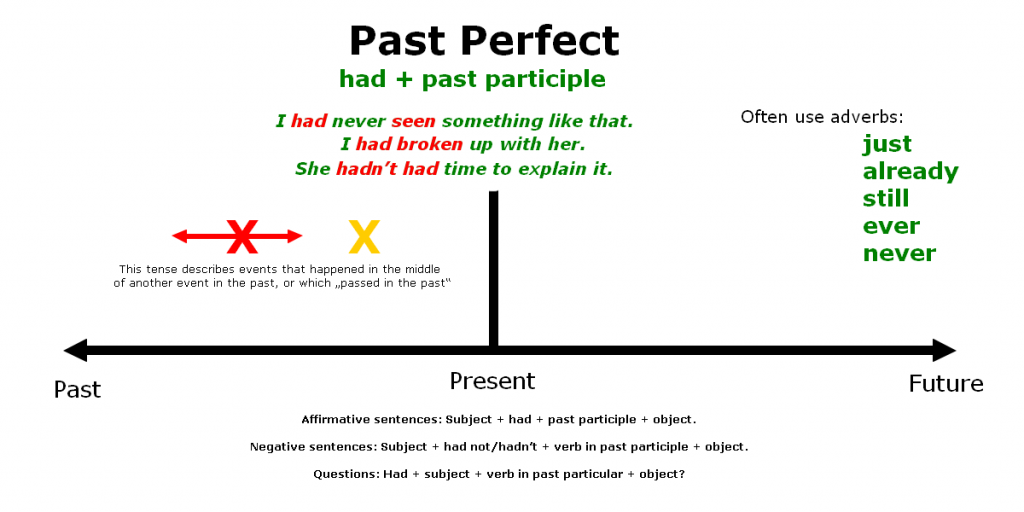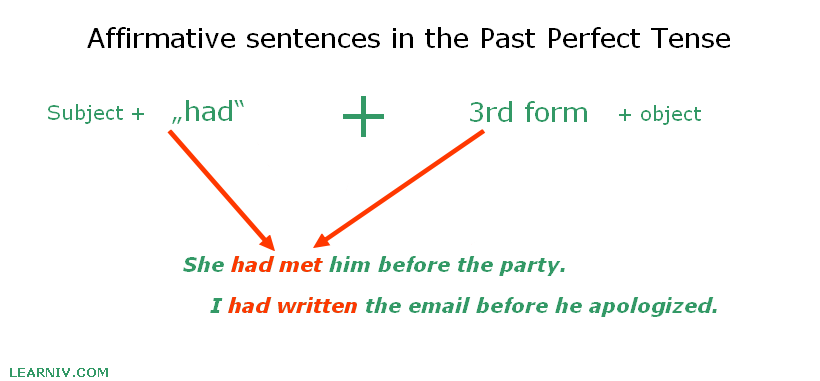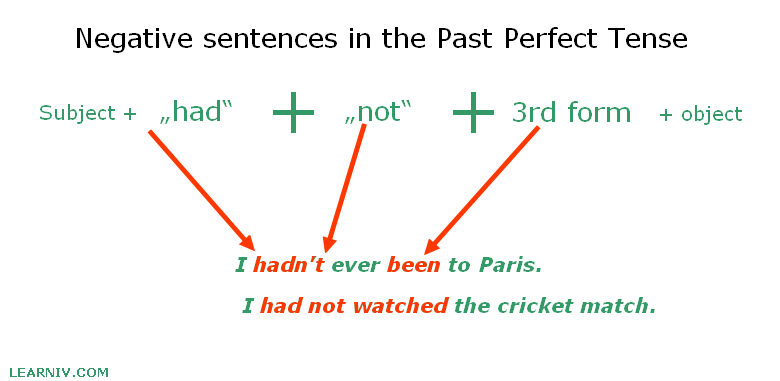The pluperfect is used for an event taking place in the past, before yet another event in the past. It is more commonly called past perfect tense.
The word pluperfect derives from the Latin “plus quam perfectum”, “more than perfect”. The word “perfect” in this sense means “completed”; it contrasts with the “imperfect”, which denotes uncompleted actions or states.
The pluperfect is typically used when we want to express which of the ongoing events took place earlier. Its use or non-use can change the meaning of the message.
Using pluperfect
Without using the past tense, we don’t know which event happened earlier.
I saw the movie in the cinema. They put the movie on a DVD.
Using the past tense, it’s clear that the movie was first in the cinema and then on DVD.
I had seen the movie in the cinema before they put it on a DVD.
In the case of our film in the cinema and on DVD, it is quite clear that the film was in the cinema first.
It’s hard to see the pluperfect in isolation. It is always context dependent. It appears exclusively in past contexts, e.g. when telling stories or events in the past, etc. It says that an activity has taken place before.
When I arrived, everyone had left.
The sentence above is a typical example of a sentence in which the pluperfect tense is used. We are talking about a specific time in the past, the time when I arrived at the place. The second act took place before that.
Stories
You will also encounter the pluperfect in storytelling, novels, etc. The stories are mostly set in the past. We use the past tense in them when we tell something that happened before the main storyline. So, for example, the main storyline is that a man walks into a restaurant, sits down, waits for a while, a woman walks up to him and hands him something under the table. All of these tense would be past simple in the novel. But now when the author of the book stops and focuses on how the man and the woman know each other, that they met that morning, for example, and arranged this secret meeting – here we use the pluperfect.
Forming the pluperfect
The pluperfect tense is formed by the auxiliary verb have in the past tense had + the past participle of the verb.
Subject + had + past participle + object.
What does it mean that the verb HAD is here as an auxiliary? It’s only there as a helper (that’s why it’s called an
auxiliary verb), but it doesn’t carry any meaning on its own. It has the function of forming an affirmative and negative sentence, a question or a short version of an answer in the past simple tense. Its role is to form the grammatical tense, so it behaves differently from ordinary full-meaning verbs, which we will see in a moment.
The auxiliary verb HAD is followed by a full-meaning verb (= one that carries meaning) in the past participle form.
The auxiliary had can be shortened to ‘d (I’d been, he’d had, we’d finished, etc.). Caution, do not confuse with the shortened woud. Visually, they look the same.
Past participle is the third verb form. For regular verbs, we add-ed and irregular verbs have special rules. We have prepared a list of irregular verbs in english.
Forming affirmative sentences
Like the present perfect tense (e.g. I have finished, he has been), the past tense is formed with the verb have and the past participle. However, the verb have will be in the past tense of had in all persons (i.e. I had finished, he had seen).
Subject + had + past participle + object.
Examples:
- I had called him before I came over.
- I had seen the movie in the cinema before they put it on TV
Shortened forms:
- I had called => I‘d called
- We had seen => We‘d seen
See also 10 more examples of Past Perfect Tense sentences in another article.
Forming negative sentences
In the negative, we add the negative particle not to the auxiliary verb (he had not been, I had not finished…).
The conjunction had not is commonly shortened to hadn’t.
Subject + had not/hadn’t + verb in past participle + object.
Examples:
- I had not called him before I came over.
- I had not seen the movie in the cinema before they put it on TV
Shortened forms:
I had not called =>I hadn’t called
I had not seen => I hadn’t seen
See also past perfect tense examples in another article.
Forming a question
In a question we reverse the order of the auxiliary verb and subject (had you seen, had I been…), but you will rarely see questions in this tense.
Had + subject + verb in past particular + object?
Examples:
- Had you seen the movie before it was on TV?
- Had she called before she came over?
What might help
Words that tell you that we should use the past tense:
- before
- after
Example:
- After the doctors had given up hope, the patient miraculously cured.
- Before I travelled abroad, I had read a lot about travelling.
A common mistake is for the student to use I hadn’t got in the past, following the pattern of the present I hadn’t got. This is wrong. The conjunction hadn’t got can only be the past tense of the verb get and not the past of the verb have.




